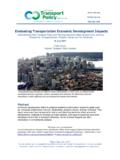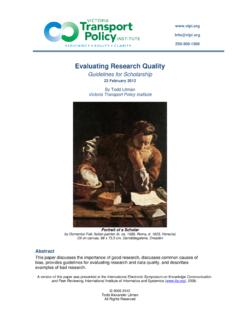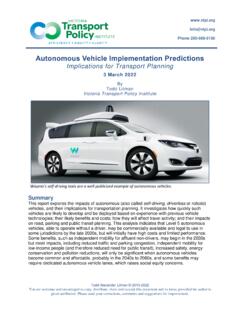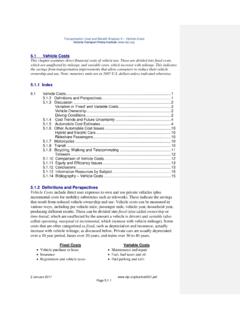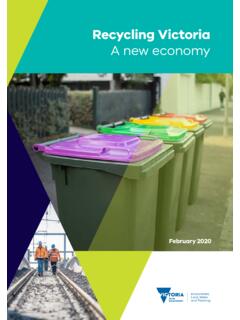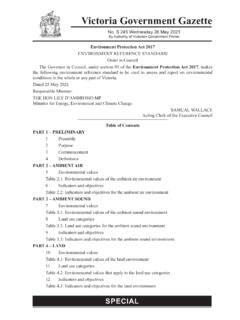Transcription of Understanding Transport Demands and Elasticities How ...
1 250-508-5150 Todd Alexander Litman 2005-2022 You are welcome and encouraged to copy, distribute, share and excerpt this document and its ideas, provided the author is given attribution. Please send your corrections, comments and suggestions for improvement. Understanding Transport Demands and Elasticities How Prices and Other Factors Affect Travel Behavior 15 April 2022 Todd Litman victoria Transport Policy Institute Abstract Transport demand refers to the amount and type of travel that people would choose under specific conditions. This report describes concepts related to Transport demand , investigates the influence that factors such as prices and service quality have on travel activity, and how these impacts can be measured using elasticity values.
2 It summarizes research on various types of Transport Elasticities and describes how to use this information to predict the impacts of specific Transport price and service quality changes. Understanding Transport Demands and Elasticities victoria Transport Policy Institute 1 Contents Executive Summary .. 2 Introduction .. 5 6 Travel Demands .. 7 Transport demand Statistics and Models .. 9 Factors Affecting Travel Demands .. 11 Demographics .. 11 Economic Activity .. 11 Transport Options .. 11 Geography and Land Use Patterns .. 12 demand Management Strategies .. 12 Prices (Monetary Costs) .. 12 Summary .. 12 Measuring Price Impacts ( Elasticities ) .. 13 Factors Affecting Price Sensitivity.
3 16 Type of Price 16 Type of Trip and Traveler .. 17 Quality And Price Of Alternatives .. 17 Scale and Scope of Pricing .. 17 Time Period .. 18 Large and Cumulative Price Changes .. 18 Price Structure .. 19 Transportation Elasticity Estimates .. 20 Summaries .. 20 Individual Elasticities .. 26 Vehicle Ownership .. 26 Income .. 26 Fuel Consumption With Respect to Fuel Price .. 27 Vehicle Travel With Respect To Fuel Prices .. 35 Road Pricing and Tolls .. 40 Mileage and Emission Charges .. 42 Parking Price .. 44 Travel Time .. 47 Generalized Costs .. 49 Transport Pricing and Development Patterns .. 49 Transit Elasticities .. 50 Air Travel .. 54 Taxi Service 55 Commute Trip Reduction Programs.
4 55 Freight Elasticities .. 56 Conclusions and Recommendations .. 57 References and Resources for More Information .. 60 Understanding Transport Demands and Elasticities victoria Transport Policy Institute 2 Executive Summary Travel demand refers to the amount and type of travel that people would choose in particular situations. Various demographic, geographic and economic factors can affect travel Demands , as summarized in Table 37. Models that reflect these relationships can predict how various trends, policies and projects will affect future travel activity, and therefore evaluate potential problems and Transport system improvement strategies. Table ES1 Factors That Affect Transport demand Demographics Commercial Activity Transport Options Land Use demand Management Prices Number of people (residents, employees and visitors)
5 Employment rate Wealth/incomes Age/lifecycle Lifestyles Preferences Number of jobs Business activity Freight Transport Tourist activity Walking Cycling Public transit Ridesharing Automobile Taxi services Telework Delivery services Density Mix Walkability Connectivity Transit service proximity Roadway design Road use prioritization Pricing reforms Parking management User information Promotion campaigns Fuel prices and taxes Vehicle taxes and fees Road tolls Parking fees Vehicle insurance Transit fares Various factors that affect Transport Demands should be considered in policy analysis and planning. Prices are the direct, perceived costs of using a good. Transport prices can include monetary (money) costs, plus travel time, discomfort and risk.
6 Price changes can affect trip frequency, route, mode, destination, scheduling, vehicle type, parking location, type of service selected, and location decisions. Pricing impacts are commonly measured using Elasticities , the percentage change in consumption (in this case, in travel activity) that results from each 1% change in price, as illustrated in Figure 11. Figure ES1 Arch Elasticities This graph illustrates how price changes affect consumption for various elasticity values. 0%50%100%150%200%250%300%-80%-60%-40%-20 %0%20%40%60%80%100%Change In Consumpion Price Change Transport Demands and Elasticities victoria Transport Policy Institute 3 Although some travel is very beneficial, the travel demand curve appears to have a long tail, meaning that if prices (monetary, time, discomfort and risk costs) decline sufficiently people will tend to increase their travel, resulting in an increasing amount of marginal value travel that provides minimal user benefits, and if they impose external costs, their net benefits (total benefits are less than total costs) are likely to be negative.
7 This lower-value travel tends to be quite sensitive to pricing. A considerable body of research has analyzed how Transport price changes affect Transport activity, including changes in fuel prices, road tolls, parking fees, fares, and Transport service quality, for various modes, user groups and travel conditions. Although these impacts vary widely, it is possible to identify certain patterns which allow these relationships to be modeled. For example: Transport pricing impacts can vary, including changes in trip generation, mode, destination, route, vehicle type and parking location. Pricing of one mode or service can affect demand of others. Pricing impacts tend to increase over time, and are typically triple over the long-run.
8 Higher value travel, such as business and commute travel, tend to be less price sensitive than lower value travel. Wealthy people tend to be less sensitive to pricing and more sensitive to service quality than lower-income people. Travel tends to be more price sensitive if travelers have better travel options. Motorists tend to be particularly sensitive to road tolls and parking fees. How fees are promoted, structured and collected can affect their impacts. Motorists are more likely to accept vehicle price increases if presented as part of an integrated program that is considered fair and provides dispersed benefits. A key factor in this analysis is the degree to which the demand factors and elasticity values collected in past studies are transferable to different times and places.
9 The basic relationships that affect travel Demands tend to be durable and therefore transferable, but it is important to take into account factors such as differences in employment rates, incomes, Transport options and land use patterns when applying past experience in new areas. The values described in this report provide a reasonable starting point for travel demand modeling but the must be calibrated to reflect specific conditions. As Transport planners, economists and modelers gain experience we will be better able to develop models for new locations, modes and pricing reforms. In recent years there has been increasing interest in transportation demand management, including pricing reforms, to achieve planning objectives such as congestion, accidents and pollution reductions.
10 Critics sometimes claim that vehicle travel is insensitive to pricing, citing studies of declining price Elasticities and examples of fuel or toll price increases that caused little reduction in vehicle travel. This implies that pricing reforms are ineffective at achieving planning objectives and significantly harm consumers. It is true that as normally measured, automobile use appears to be inelastic, meaning that price changes cause proportionately smaller changes in vehicle travel. However, Understanding Transport Demands and Elasticities victoria Transport Policy Institute 4 this reflects how price impacts are normally evaluated. Short-run price effects are about a third of long-run effects, and most vehicle costs (depreciation, financing, insurance, registration fees and residential parking) are fixed.
